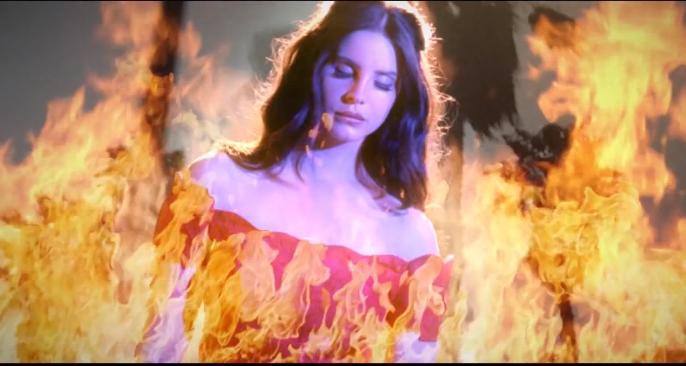The Collage Artist
by Phil Freeman

If Lana Del Rey were a Tumblr, she would be photos of Elvis, classic cars, movie posters, and vintage paperback covers, broken up by YouTube clips of singers performing string-slathered ballads on decades-old TV shows. Her early self-descriptions — “gangsta Nancy Sinatra,” “Hollywood sadcore” — seem to suggest meaning. But when you think about them too long, they dissolve into nothingness. That vagueness — the hand-waving in the direction of something that once meant something specific, but is now an archetype, hollow and half-obscured by a glow of glamor and nostalgia — is her artistic strategy. And it’s working: Lana Del Rey is appealing because she is a self-curated collage of references and images in which she sees her reflection, just like the rest of us.
Del Rey’s first video, the brilliant “Video Games,” was a laptop-assembled mash of selfie-like headshots, paparazzi footage of Paz de la Huerta falling down at a public event, American flags waving, skateboarders, and movie clips. Del Rey quickly abandoned this low-budget approach; later videos, particularly “Born To Die,” the JFK-inspired “National Anthem,” and “Ride,” assembled “all-American” cultural iconography into hyperreal tableaux, like Guess Jeans commercials directed by Matthew Barney. The combination of catalog-model looks, deadpan singing and the lush, often seemingly half-speed music gave her work the power of a recurring dream.
Yet, while Del Rey’s videos are lavishly over the top and directed with breathtaking precision, her lyrics are minimalist, attempting to sketch stories in a line or two through the use of familiar images — familiar not because they have any particular resonance or specificity, but because they’re songwriting clichés, like starting a blues number with “Woke up this morning.” She frequently deploys such totemic objects as shorthand characterization — “he drives a Chevy Malibu,” Beat poetry, jazz records, black nail polish, hydroponic weed, and lines of cocaine. On “Cruel World,” the opening track from her new album Ultraviolence, she croons, “You got your Bible and your gun.” That’s fine, the juxtaposition is a familiar one. But then she follows it with, “You like your women and you like fun,” a line so giddily dumb that it recalls Iggy Pop’s “I love girls/They’re all over this world,” from 1979’s New Values. She nods to pop music history at times, too: “He hit me and it felt like a kiss,” she sings on the album’s title track, quoting a Crystals song that wasn’t even a single back in 1962, but which has gained a cultish afterlife, particularly since being covered by Hole.
Even when the lyrics seem half-finished, the music is impressive. The first sound heard on Ultraviolence is a twanging guitar that wouldn’t seem out of place on a Dusty Springfield record, bolstered by thumping cardboard-box drums and a psychedelic echo effect like an owl hooting in a tunnel. Mostly produced by Dan Auerbach of the Black Keys, Ultraviolence falls somewhere between countrypolitan Nashville and Phil Spector’s Wall of Sound, the guitars mostly twangy and reverb-soaked, occasionally veering toward psychedelia (the solo at the end of “Pretty When You Cry” sounds like a studio pro doing his best David Gilmour impression). There are synth and mellotron strings, pedal steel, and saxophone here and there. The drums have a subdued boom, like underwater explosions. Close your eyes and you can picture stoic studio musicians recording these tracks in a cavernous white-walled studio, Del Rey singing into one of those big vintage microphones. It’s a retro sound, but not reactionary. As ever, the goal is to go big, to be widescreen and awe-inspiring, and it works. This album should be played on a loop in a room at the Whitney.
There are no uptempo songs on Ultraviolence; it seems to drift by in slow motion. “Cruel World” flows along with a dreamlike slowness, the arrangement growing measure by measure until, when the chorus arrives, it erupts like Jane’s Addiction’s “Up the Beach.” Still, the words refuse to elevate things to the epic level the music seems to demand; they’re a bare-bones sketch of a dead relationship. “I’m finally happy/Now that you’re gone,” Del Rey sings, though her voice — half Françoise Hardy, half Nico, and slurring like she’s a little bit drunk — betrays no pleasure. Occasionally, her voice slips out of control, as on the deliberately raw first verse of “Pretty When You Cry” or the baby talk she slips into on several tracks. When she really lets her voice rip, she’s got an impressive range. But she doesn’t do it often, probably because it would bring her too close to breaking character. Restraint, and keeping the world at a distance, whether through music of an otherworldly lushness or lyrics so seemingly banal they’re almost alienating, is key to the performance.
Lana Del Rey is a Cornell box of twentieth century cultural icons — her brilliant half-hour film from last year, Tropico, gives us John Wayne, Elvis and Marilyn Monroe, plus quotations from Walt Whitman and Allen Ginsberg — all gathered, layered and juxtaposed in an attempt at creating an identity which can then be performed. Similarly, her impassive expression, regarding us from behind an open car door on Ultraviolence’s cover, invites us to make her art an element in our own collages. We can add “Lana Del Rey fan” to the list of things we tell others, when we need to “reveal” “who” “we” “are.”
Phil Freeman is the editor of burningambulance.com.
